Are you ready to discover a world where gardens flourish rapidly right before your eyes? The fastest-growing vegetables on the planet are not only fun to watch, but they also promise a quick harvest. As we explore this list of speedy vegetables, you’ll learn how easy and rewarding quick gardening can be. It’s a fun, fresh way to enjoy nature, and you’ll love watching your garden flourish day by day. So, without further ado, let’s discover the 14 fastest-growing vegetables in the world!
1. Microgreens – 1 to 2 Weeks
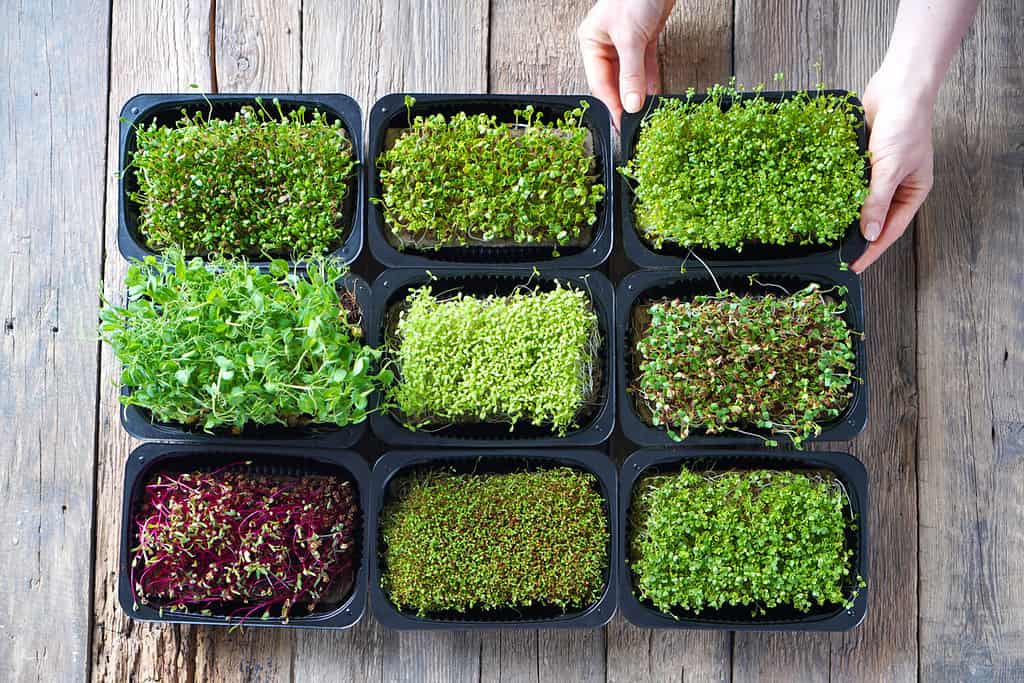
The fastest-growing vegetables are microgreens.
©Varavin88/Shutterstock.com
Often, radishes are celebrated as the fastest-growing vegetables, but in reality, microgreens hold the crown.
Microgreens are emerging as a trendy replacement for the usual salad greens. They can sprout from a wide range of plants, though arugula, spinach, celery, and chives are super popular. The term “micro” hints at their stature. They are the young seedlings of edible vegetables and herbs.
These tiny greens resemble miniature two-leaf clovers. They are the first leaves from seeds that emerge above the soil. Initially white, they turn green when they come into contact with light due to the process of chlorophyll biosynthesis, growing to a modest height of 1.5 to 3 inches.
To grow, use shallow trays with a depth of around 3-4 inches and fill them with a seed starting mix. Spread the seeds generously, with no need to worry about spacing. Once they have sprouted, relocate the trays to a place with indirect light to foster ideal growth.
Their small size makes it possible to grow them throughout the year, and they’ll be ready to grace your plate just one or two weeks after sowing.
2. Cress – 1 to 3 Weeks
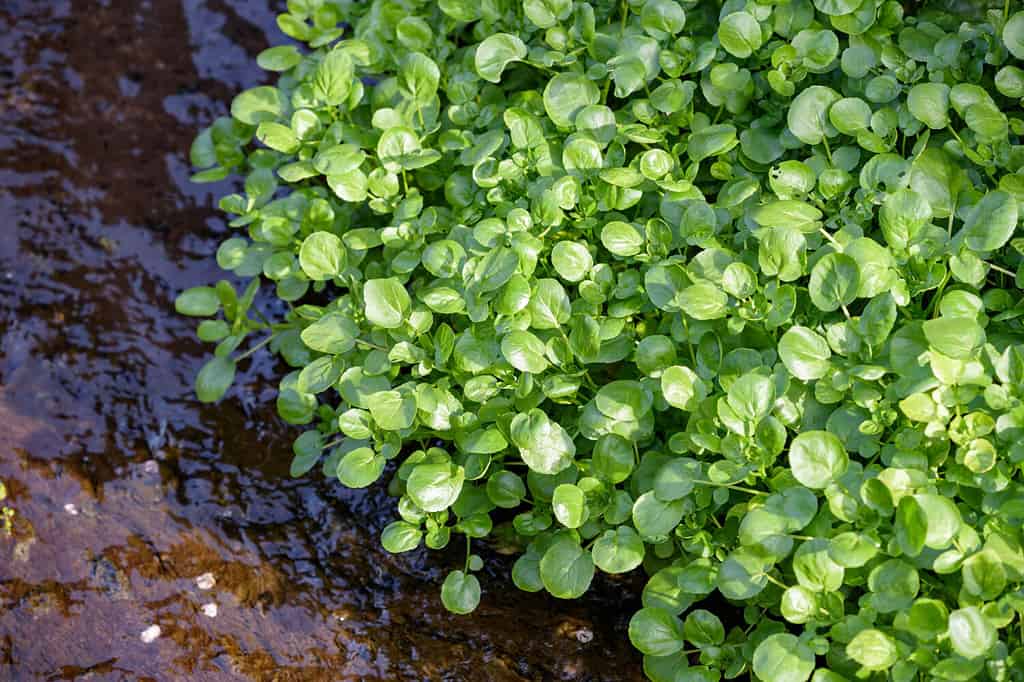
Cress varieties, such as watercress, grow super fast in just a matter of a couple of weeks!
©Picmin/Shutterstock.com
Closely following microgreens, cress secures the spot as the second fastest-growing vegetable, also recognized by the name garden cress.
This green leafy vegetable is consumed widely, with its looks slightly varying based on its specific type. The most recognized variety among them is watercress. Both the foliage and blooms of cress are edible. Leaves can reach a length of 2 inches.
Cress thrives in damp soil and can be grown in any kind of container. Scatter the seeds on the surface and cover them to keep the moisture intact until germination kicks in. After that, move them to a well-lit area. Harvesting is as simple as snipping them close to the base using a pair of scissors.
Sow the seeds in your garden with the onset of spring, preferably 4 to 6 weeks before the last frost, or grow it indoors all year round. The rapid growth of cress is remarkable; in 7 to 20 days, it will yield a ready-to-harvest green.
3. Arugula – 3 to 4 Weeks

Arugula is a popular leafy green that grows within a month.
©vaivirga/Shutterstock.com
Among the rapid growers, arugula stands out as a leafy green that shot to popularity in the United States during the 1990s.
Sporting a deep green color, its leaves have notable notches along both edges. While some leaves feature full, round tips, others exhibit a more pointy end. Commonly savored raw in salads, arugula can also be a delightful addition to various cooked meals as well, with its leaves growing to around 3 to 6 inches.
Being a cool-season annual, arugula performs well during the spring or fall. It thrives best under abundant sunlight and in fertile, well-draining soil. Like other green-leafed herbs or vegetables, arugula appreciates a good amount of compost or fertilizer. Watering is only called for when the soil begins to dry out.
The quick growth of the arugula is a highlight, allowing for an early harvest post-sowing. The specific variety of arugula you choose to plant will dictate the exact harvesting time, but generally, a short wait of 3 to 4 weeks post-sowing will have it ready for harvest. However, note that it may take as long as 7 weeks in some cases.
4. Radish – 3 to 5 Weeks

In 3 to 5 weeks, you can harvest radishes.
©Natallia Ploskaya/Shutterstock.com
Radishes are known for their rapid growth, largely due to their seeds’ prompt germination.
These are either annual or biennial plants from the Brassicaceae family, cultivated for their distinctive swollen tap roots. The exterior color of these roots can be in different colors, though the inside usually remains white. Most radishes are round, with a diameter of about an inch.
Preferring the cooler weather, radishes are cold weather tolerant. It’s advisable to loosen the soil to a depth of six inches or more before planting, especially for the longer types. The ideal planting window runs from April to early May and then again in August. It’s crucial to avoid drought stress as it could result in roots with a bland taste and tough texture.
You can expect to harvest radishes within a short span of three to five weeks following planting.
5. Bok Choy – 4 to 6 Weeks

The popular bok choy generally reaches maturity in 50 to 70 days, but you can harvest them earlier.
©Nungning20/Shutterstock.com
Bok choy is a unique green vegetable belonging to the cruciferous family. Unlike its relatives commonly found in the United States, like cabbages, Brussels sprouts, and broccoli, bok choy doesn’t form a “head.”
This vegetable comes with either white or green, firm, crunchy stems paired with wide leaves that range from light to dark green. The size of bok choy can vary widely, standing anywhere between 4 to 12 inches tall! Both its stems and leaves are edible, making it a versatile choice for cooking.
For the best growth, bok choy prefers a sunny spot, although it appreciates a bit of afternoon shade when the temperatures soar. It thrives in moisture-retentive soil. If garden space is a constraint, fret not, as bok choy can also be comfortably grown in large containers.
Plant bok choy outdoors during the early spring for a late spring harvest or from late summer to early fall for a late fall yield. If you opt for an early spring planting, initiate the germination process indoors, transplanting them to your garden soil once the threat of the last frost has passed.
Most bok choy cultivars reach maturity between 50 to 70 days. However, tender baby leaves can be harvested as early as 4 to 6 weeks after planting.
6. Mustard Green – 4 to 6 Weeks
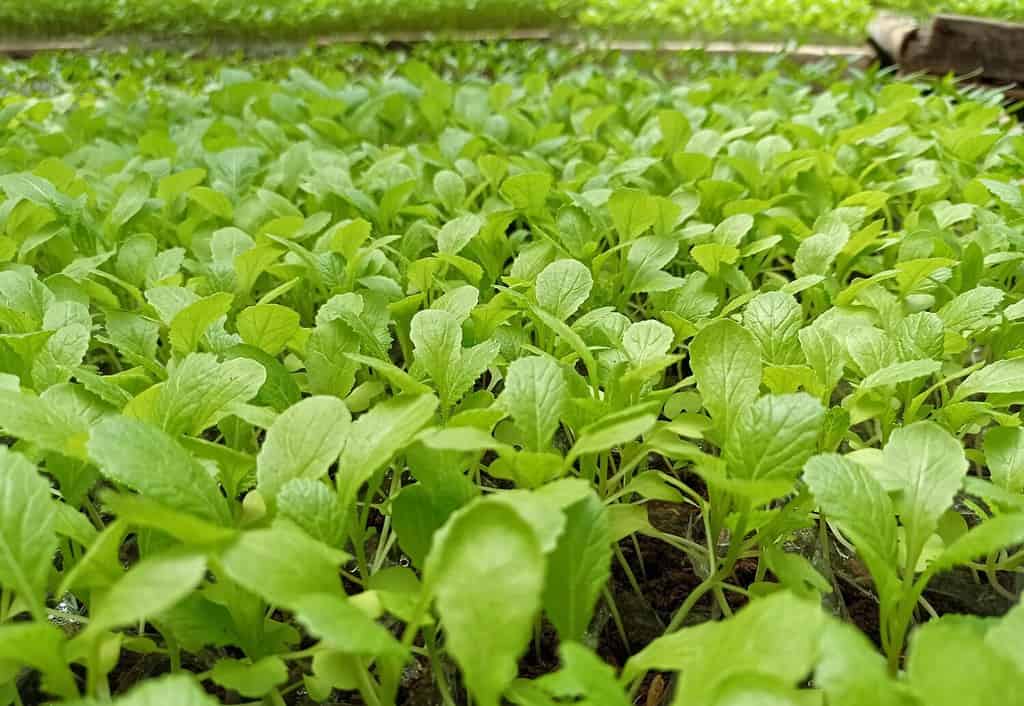
Mustard greens are one of the fastest-growing vegetables in the world.
©ByPict projects/Shutterstock.com
Joining the ranks of rapid-growing leafy greens, mustard greens share a family tree with kale, collards, and cabbage.
These greens boast broad, undulating leaves, typically dark green or purple in color. They stand upright, their growth aided by prominent longitudinal veins. The speedy growth of mustard allows for an early harvest once the leaves reach a length of 6 to 8 inches.
While mustard green is adaptable to most soil types, it flourishes in rich, well-drained, and well-prepped soil with a pH level of 6.0 to 6.8. It appreciates consistent moisture, thriving especially well in cooler climates; a touch of light frost might even enhance its flavor.
Sow the seeds 6 to 8 weeks before the first fall frost or 4 to 6 weeks prior to the last spring frost. You can start enjoying mustard greens as soon as 4 weeks post-planting. If left to grow, the leaves can achieve their full size of 15 to 18 inches in approximately 6 weeks.
7. Baby Carrots – 4 to 6 Weeks
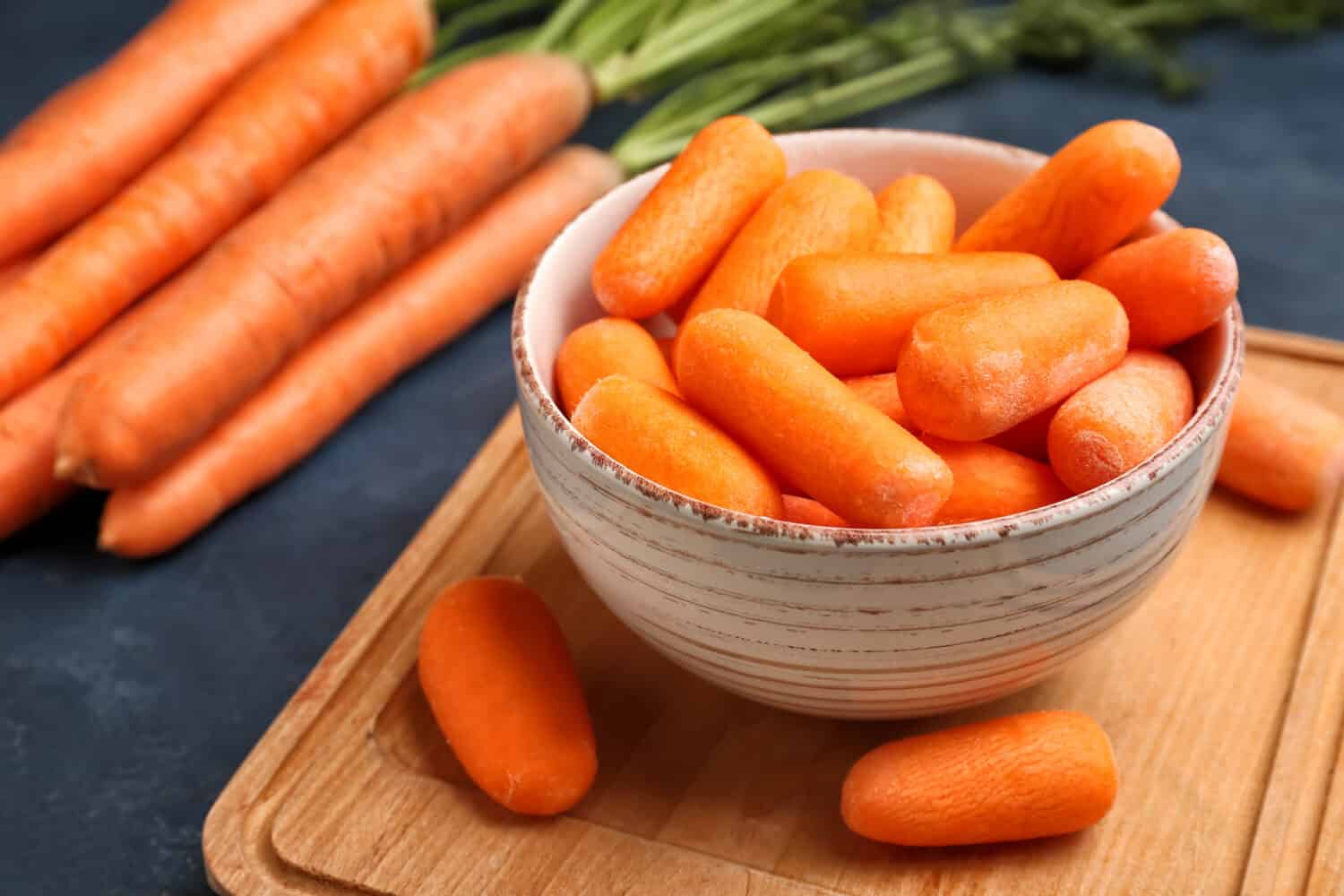
Since baby carrots are, well, babies of mature carrots, you can harvest them much sooner.
©Pixel-Shot/Shutterstock.com
A baby carrot is essentially a carrot that’s picked before it fully matures.
Common baby carrots sport the same vibrant orange taproots as their larger counterparts, but they bring a tender texture and generally a sweeter taste to the table. On average, baby carrots measure between 3 to 5 inches in length.
For those interested in growing baby carrots at home, starting with seeds of a miniature carrot variety is the way to go. Plant these seeds in loose, stone-free, compost-enriched soil, ensuring regular and even watering. They thrive in sunny spots, soaking up to 6 to 8 hours of sunshine daily.
The sowing season extends from early spring all the way to late August, allowing for nearly year-round harvesting. The majority of varieties are typically sown outdoors between April and July.
While many carrot varieties require 8 to 12 weeks to reach maturity from the time of seeding, you can harvest some varieties in just 4 to 6 weeks.
8. Lettuce – 4 to 8 Weeks
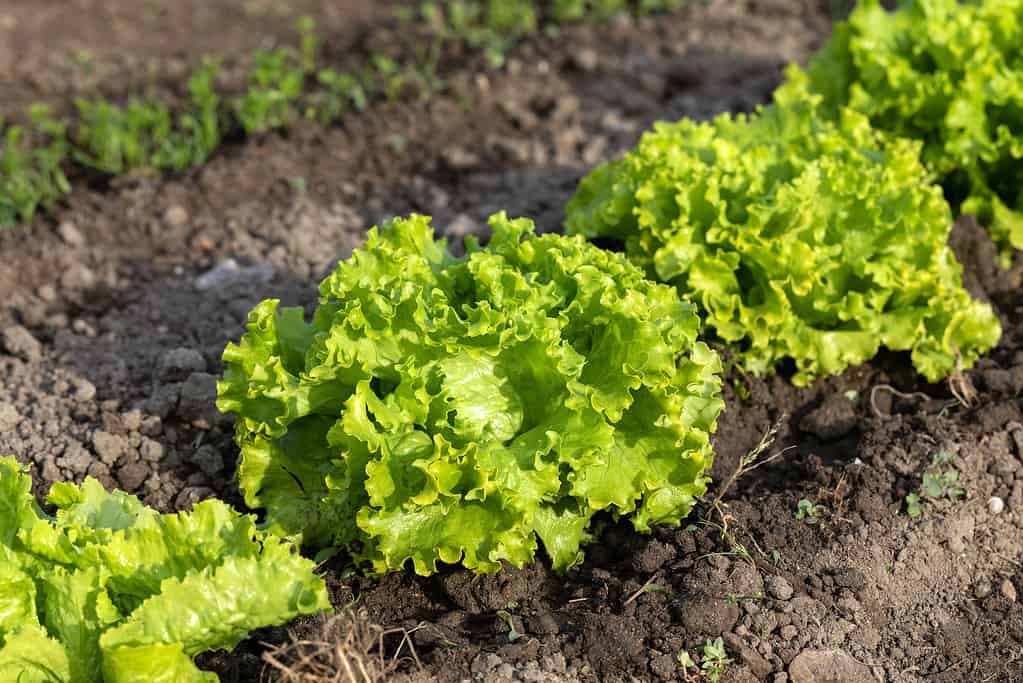
Another one of the most popular fastest-growing vegetables is lettuce.
©Thomas Pajot/iStock via Getty Images
Lettuce — a staple in numerous salads and a common addition to sandwiches — is the most popular leafy green in the United States. The cherry on top? It’s among the fastest-growing vegetables!
The plant has a short stem, with larger leaves clustered at the base, gradually decreasing in size as they ascend the stem. The leaves can be either smooth or curly, showcase a color palette of green or red, and usually measure around 3 to 4 inches in length.
For optimal growth, choose a spot with abundant sunlight and soil that drains well. The cool days of spring and fall are the prime time to plant lettuce. Given its shallow root system, it’s wise to check the soil twice a week, watering whenever the top inch dries out. A 3-inch layer of mulch can be a great aid in retaining soil moisture.
The timing for harvesting lettuce can be quite flexible, largely depending on your preference. While each variety has its own growing season duration, most reach maturity between 4 to 8 weeks. If you’re keen on an early harvest or just fancy some fresh leafy greens, feel free to pluck individual leaves whenever you desire.
9. Spinach – 6 to 8 Weeks
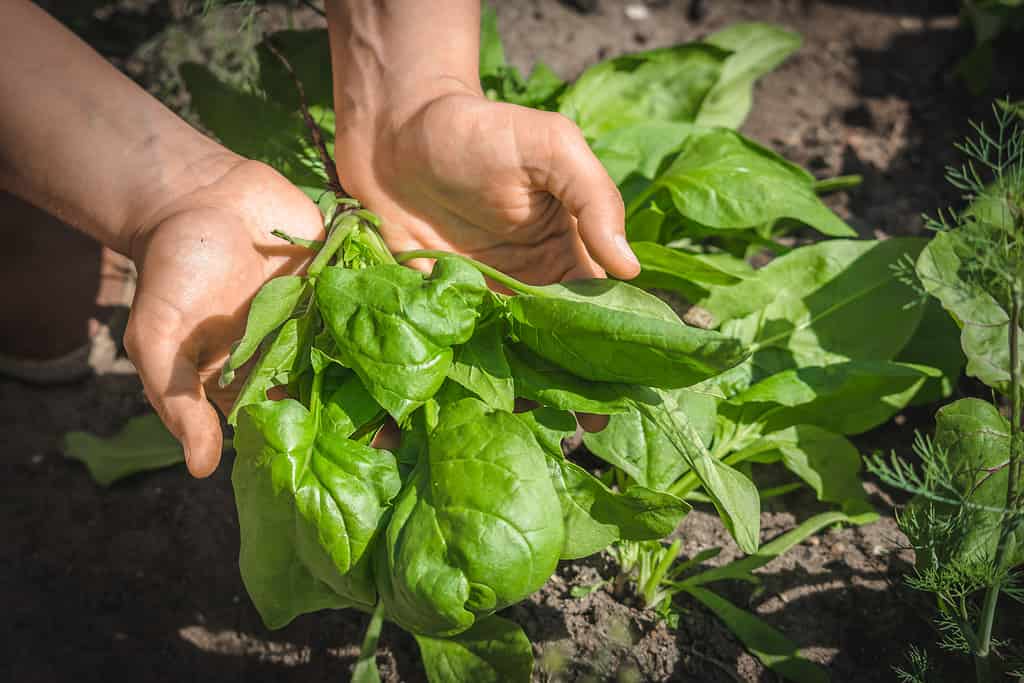
You can harvest spinach as early as 6 weeks.
©alicja neumiler/Shutterstock.com
Spinach thrives in cooler weather, sharing a botanical family with beets and Swiss chard. As a quick grower, it produces a bounty of leaves in a short span.
This herbaceous plant boasts green leaves arranged in a rosette formation, which can be enjoyed either raw or cooked. The leaves are oval, bearing a wrinkled texture, with edges that can be smooth or serrated. They are alternately arranged, simple in form, with a size that varies widely, ranging from 1 to 12 inches in length.
Maintaining a good level of moisture is key to growing spinach. The soil should remain moist without being waterlogged. Applying mulch helps retain soil moisture, ensuring steady growth. While spinach prefers a sunny spot, it can also thrive in partial shade.
The ideal time to plant spinach is in the tail end of winter or the onset of spring for a quick harvest, or once again as summer wanes into fall, post the peak hot temperatures.
Depending on the variety, spinach is ready for harvest within a window of 6 to 8 weeks. You have the choice to harvest it as baby spinach or wait a bit longer for mature, full-grown leaves.
10. Turnip – 6 to 10 Weeks

A popular root veggie, the turnip is one of the fastest-growing vegetables.
©Hecos/Shutterstock.com
The turnip is a root veggie widely cultivated across the globe.
Its leaves are fuzzy, green, and accompanied by juicy stems that often exhibit a purple hue. They resemble mustard greens, though they tend to be less curly. The roots of turnips are round, showcasing a white or white-and-purple exterior, while the inside reveals a smooth, crisp white flesh. The root has a rounded form, ranging from 2 to 7 inches in diameter, and lacks side roots.
For planting, opt for early varieties up through June, transitioning to maincrop varieties in July and August. Turnips prefer cooler climates, leading to swift and plentiful germination during spring, whereas hot, dry weather might hinder successful germination. They thrive in moisture-holding soil situated in a sunny, open area.
Turnip roots grow quite fast, with early varieties being ready for harvest in six weeks and maincrops in about ten weeks. It’s advisable to harvest them while they are small and flavorful. If allowed to grow larger than a tennis ball, they may become woody and acquire a bitter taste.
11. Green Onion – 7 to 8 Weeks
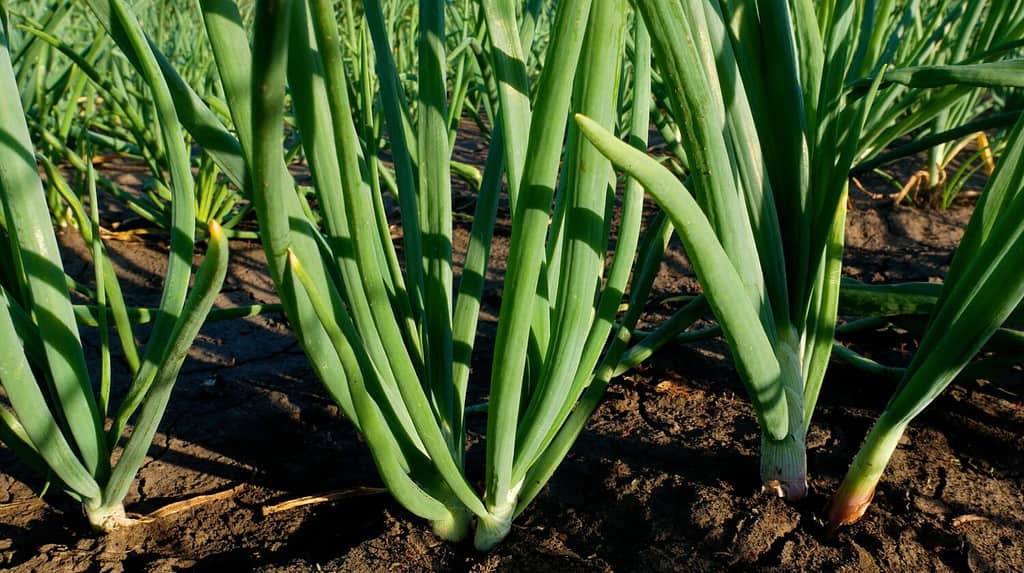
Generally, you can harvest green onion after 7 to 8 weeks.
©Seneline/Shutterstock.com
In contrast to bulb onions, green onions are fast growers! This pleasant crop is entirely edible, grows rapidly, and occupies minimal space in your garden.
Green onions feature a long, slender green stem that whitens near the root. Both the white and green segments of the stem are suitable for cooking, while the roots are usually removed and discarded. The harvest maturity stage is commonly recognized when the diameter at the base plate of the immature bulb ranges between 1/4 to 1/2 inch.
Similar to many vegetables, green onions flourish under ample sunlight, so a spot with a daily dose of 6 to 8 hours of direct sunlight is preferable. They thrive in fertile, well-draining soil, making raised beds an excellent choice for their cultivation.
To get a head start on the growing season, plant green onions indoors 8-10 weeks before the last frost. Alternatively, sow them directly outdoors throughout the summer and into the early fall.
Typically, the journey from seed to harvest spans 7 to 8 weeks, although green onions are still enjoyable before and after this timeframe.
12. Kale – 7 to 9 Weeks
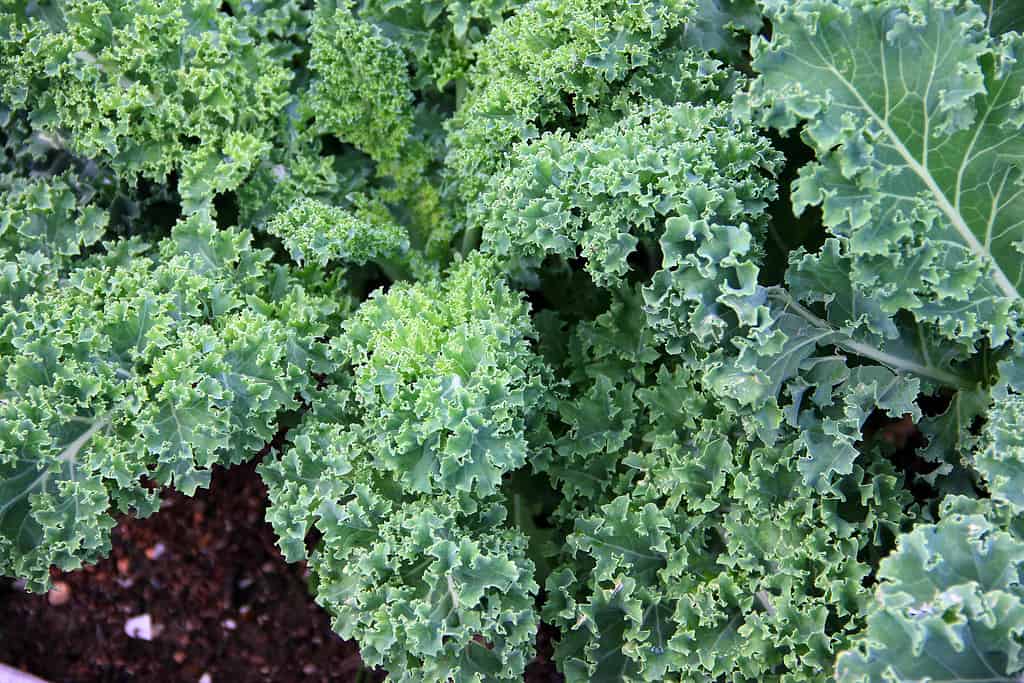
When your kale plants grow to around 12 inches tall, harvest them.
©/ via Getty Images
Kale is part of a variety of cabbage cultivars primarily grown for their nutritious leaves, though a few are appreciated for their ornamental value.
The plants boast a rosette of elongated leaves with margins ranging from wavy to frilly. While the leaves are mostly blue-green, they can also come in shades of light green, red, or purple, varying with the type.
For the quickest growth and tenderest leaves, a spot with full sun and fertile, well-draining soil is ideal, although kale can also handle a bit of shade. It’s a good practice to enrich the soil with ample compost before planting.
Planting kale in spring sets the stage for a leafy harvest from fall onward, while a late fall sowing ensures a supply of greens through winter and spring.
Once the kale plant stands about 12 inches tall and the outer leaves stretch roughly to the length of your hand, it’s time for harvest. This stage generally arrives 7 to 10 weeks post-seeding, marking kale as one of the fastest-growing vegetables in the world.
13. Cucumber – 7 to 10 Weeks
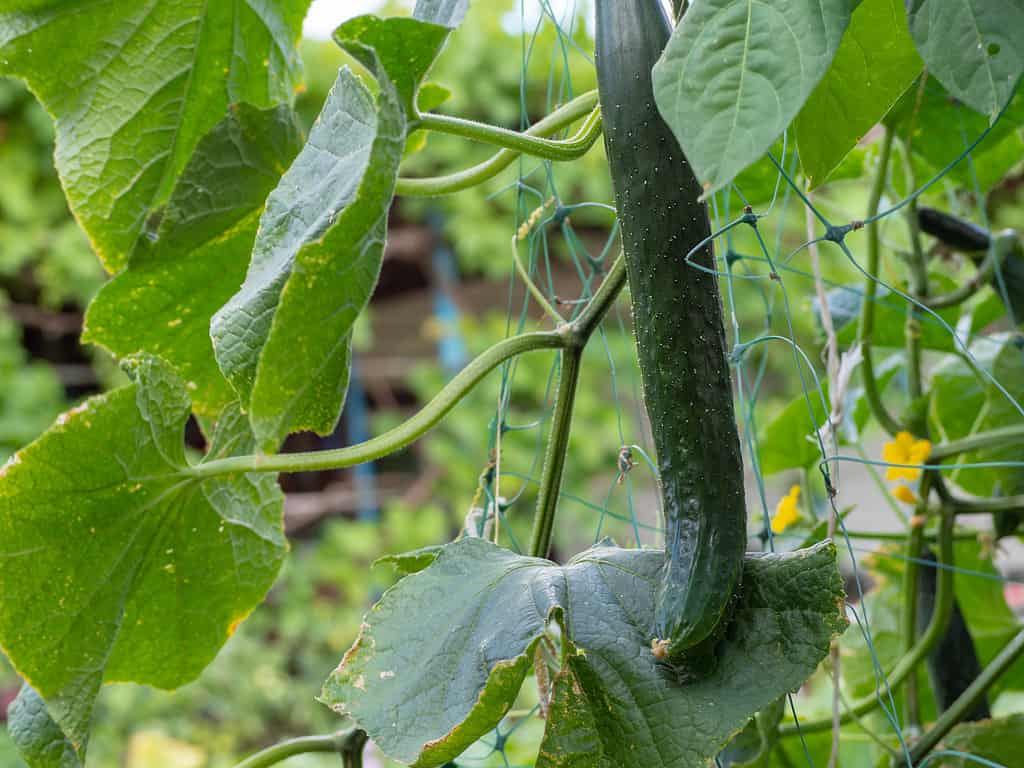
Harvest cucumber in 7 to 10 weeks after planting.
©Aleksandr Krotkov/iStock via Getty Images
Cucumbers are a breeze to grow, and they sprout up quickly!
The typical cucumber is a slender cylinder with tapered ends and can be quite long, sometimes reaching 24 inches, with a diameter of up to 4 inches. Despite their solid appearance, they are composed of 95% water. While the green variants are most common, cucumbers can surprise you with a variety of colors, including white, yellow, and even orange.
These plants appreciate sunlight, but too much can cause scorching, so a bit of shade is beneficial. They require a moderate amount of nitrogen, along with higher levels of phosphorus and potassium. It’s important to keep the soil well-watered to prevent the cucumbers from tasting bitter.
Cucumbers thrive in warm weather conditions. It’s a good idea to start the seeds indoors in late April for transplanting later on. Alternatively, directly sow in the garden once the soil warms up, typically in May.
Depending on the variety, cucumbers are ready for harvesting in 7 to 10 weeks. They are most delicious when harvested while still small.
14. Peas – 8 to 10 Weeks
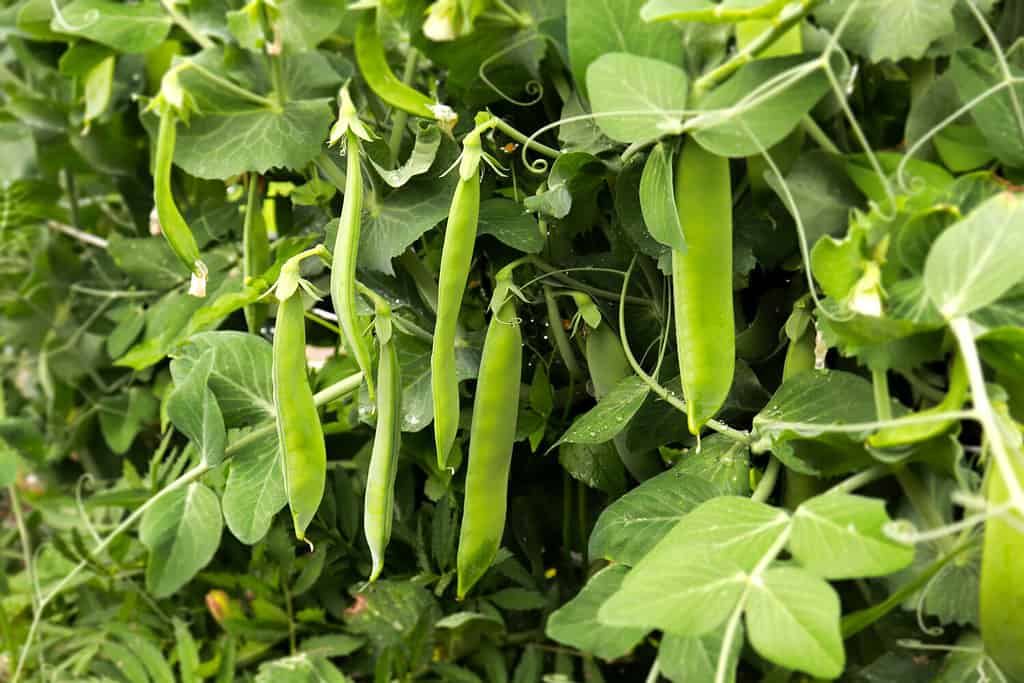
Peas are a favorite vegetable to grow in any garden.
©Natallia Ustsinava/Shutterstock.com
Last on this list of fast-growing vegetables are peas!
Encased in a pod, each pea is smooth to the touch with a bright color. Available in various forms like frozen, canned, dried, or fresh, peas are versatile for many culinary uses.
Peas require a good dose of sunshine, about six to eight hours of direct sunlight daily, although they can manage in partial shade, albeit less robustly. While they adapt to different soil types, they do best in well-drained, loose, and rich soils with a pH range of 6.0 to 7.5. Lighter soils are preferable for early varieties, as heavy, organic matter-rich soils may lead to lush foliage but fewer pods.
Plant your peas anytime from March through early July. For a head start on harvesting, which would be around May, consider sowing in the fall or late winter, though be mindful that colder weather might pose a challenge.
Typically, most pea varieties are ready to greet the harvest basket in 8 to 10 weeks.
Summary of the Fastest-Growing Vegetables in the World
| Rank | Vegetable | Timeframe |
|---|---|---|
| 1. | Microgreens | 1 to 2 Weeks |
| 2. | Cress | 1 to 3 Weeks |
| 3. | Arugula | 3 to 4 Weeks |
| 4. | Radish | 3 to 5 Weeks |
| 5. | Bok Choy | 4 to 6 Weeks |
| 6. | Mustard Green | 4 to 6 Weeks |
| 7. | Baby Carrots | 4 to 6 Weeks |
| 8. | Lettuce | 4 to 8 Weeks |
| 9. | Spinach | 6 to 8 Weeks |
| 10. | Turnip | 6 to 10 Weeks |
| 11. | Green Onion | 7 to 8 Weeks |
| 12. | Kale | 7 to 9 Weeks |
| 13. | Cucumber | 7 to 10 Weeks |
| 14. | Peas | 8 to 10 Weeks |
The photo featured at the top of this post is © Natallia Ploskaya/Shutterstock.com
Thank you for reading! Have some feedback for us? Contact the AZ Animals editorial team.







